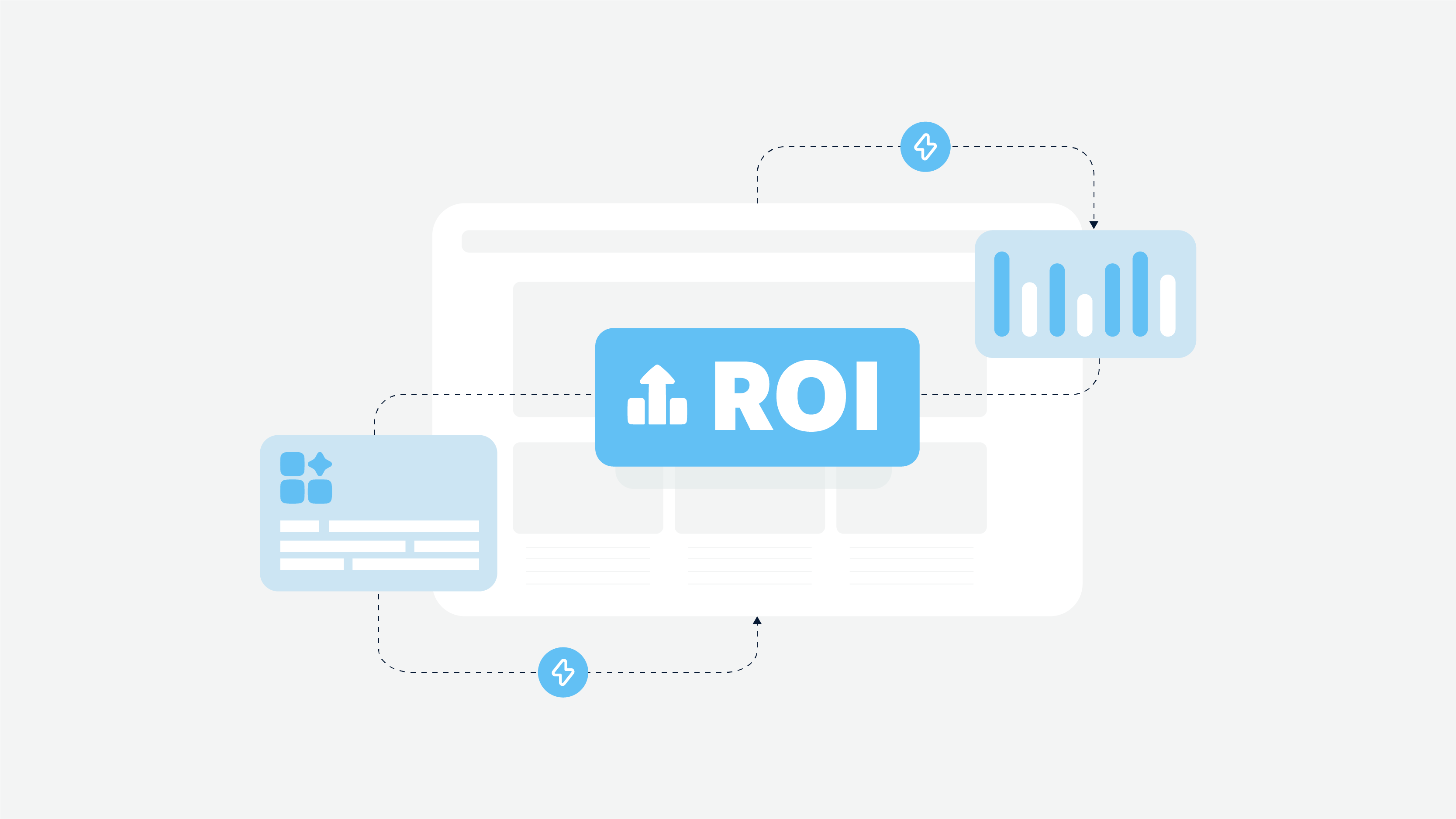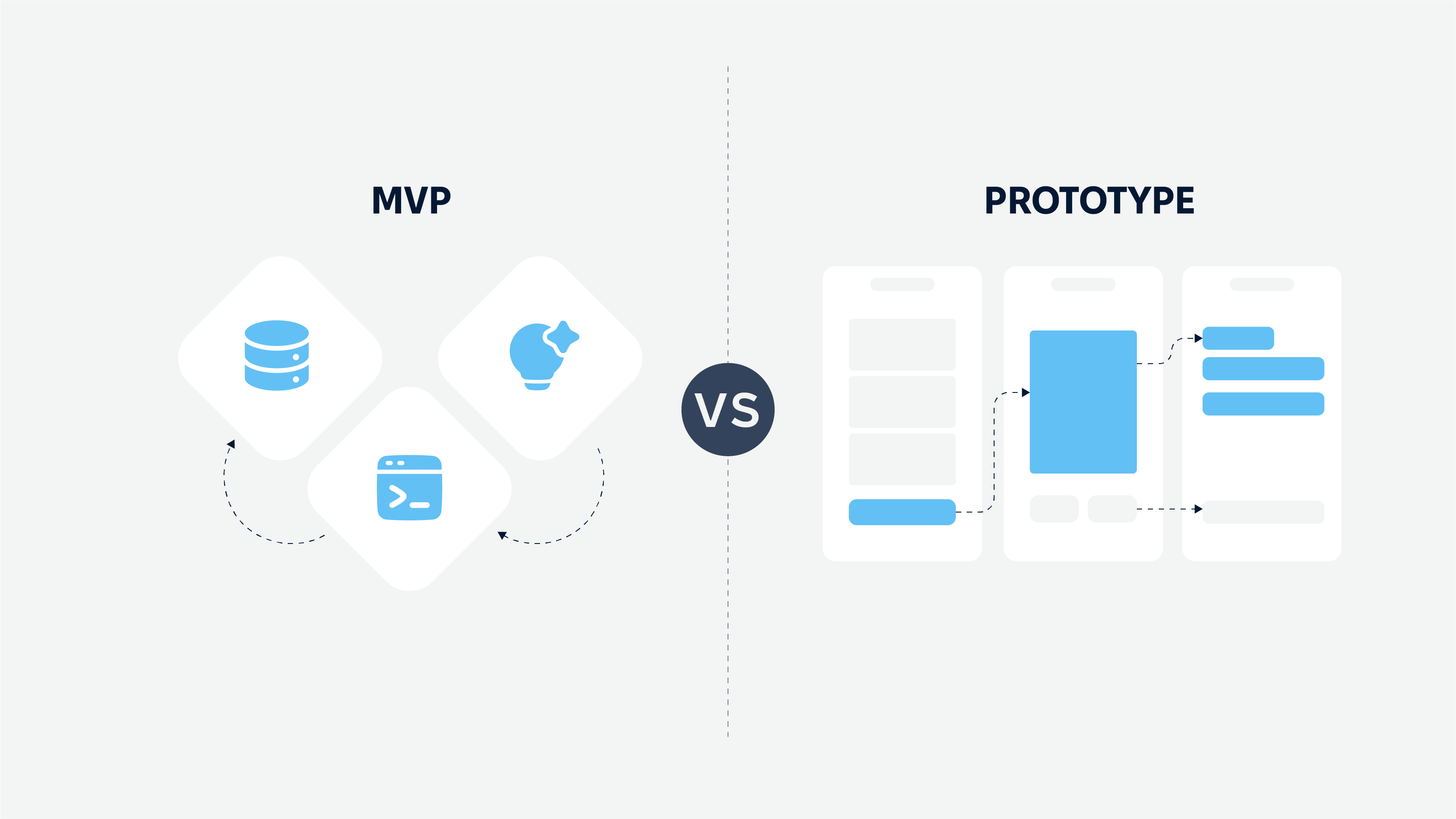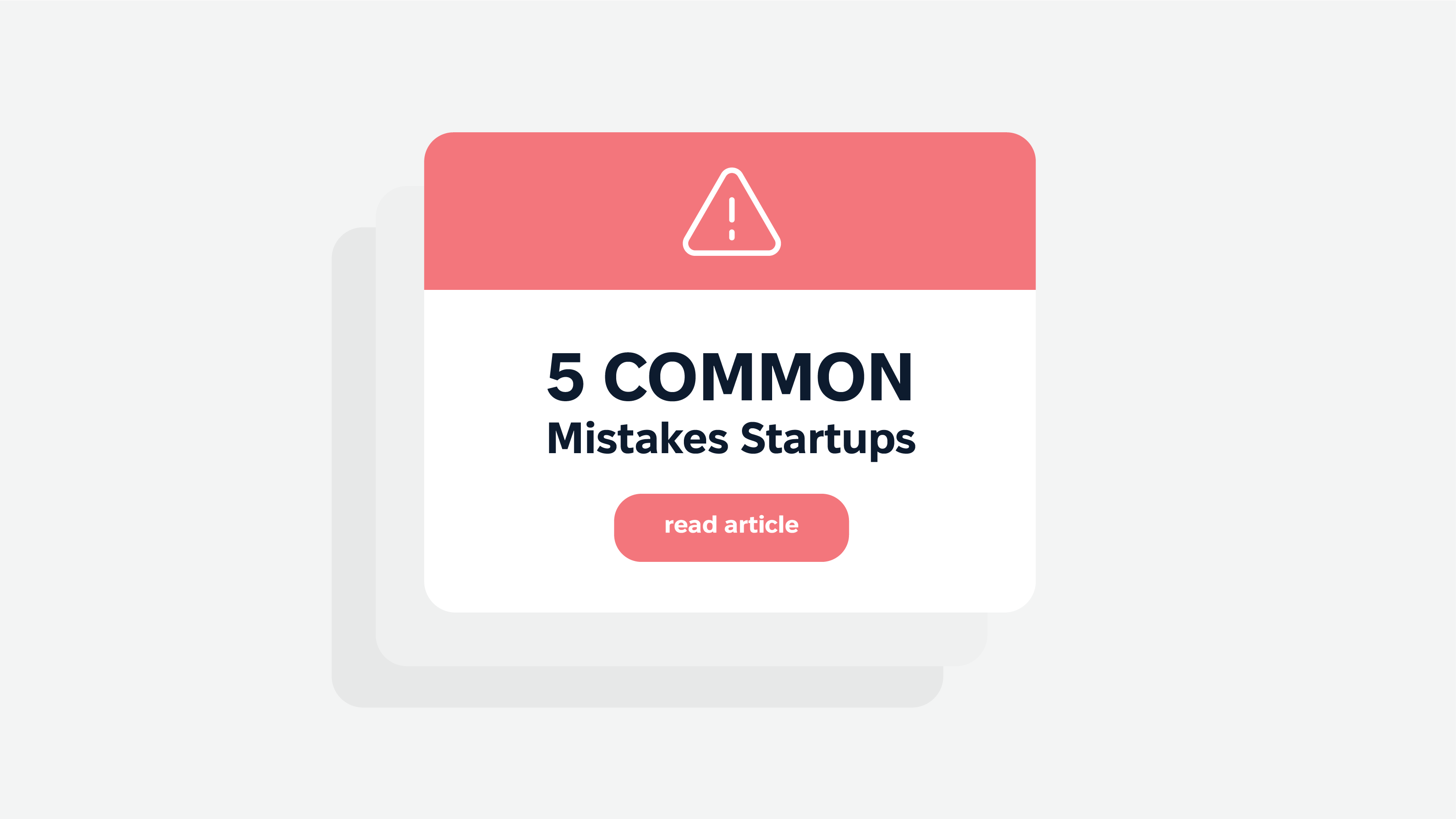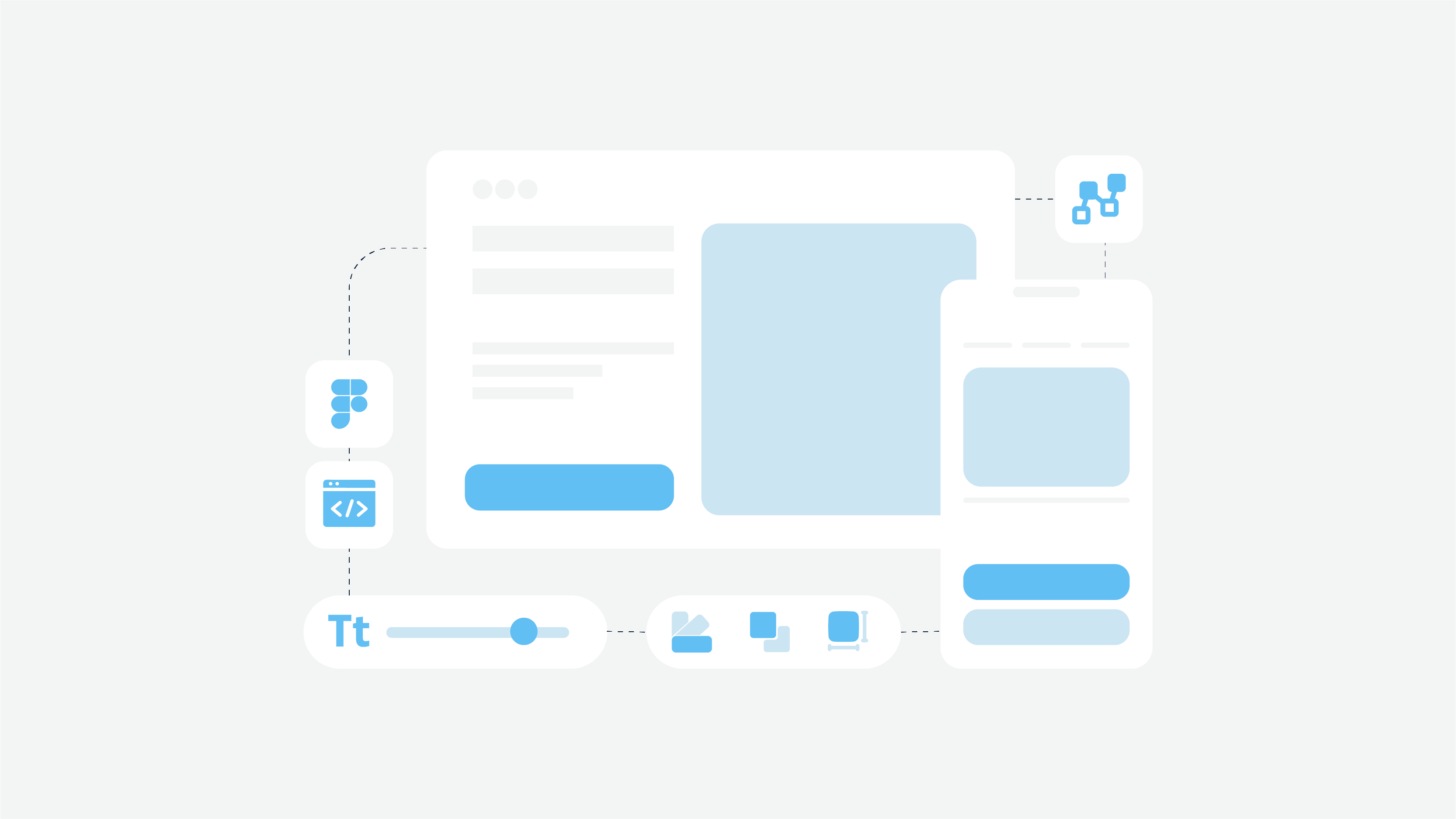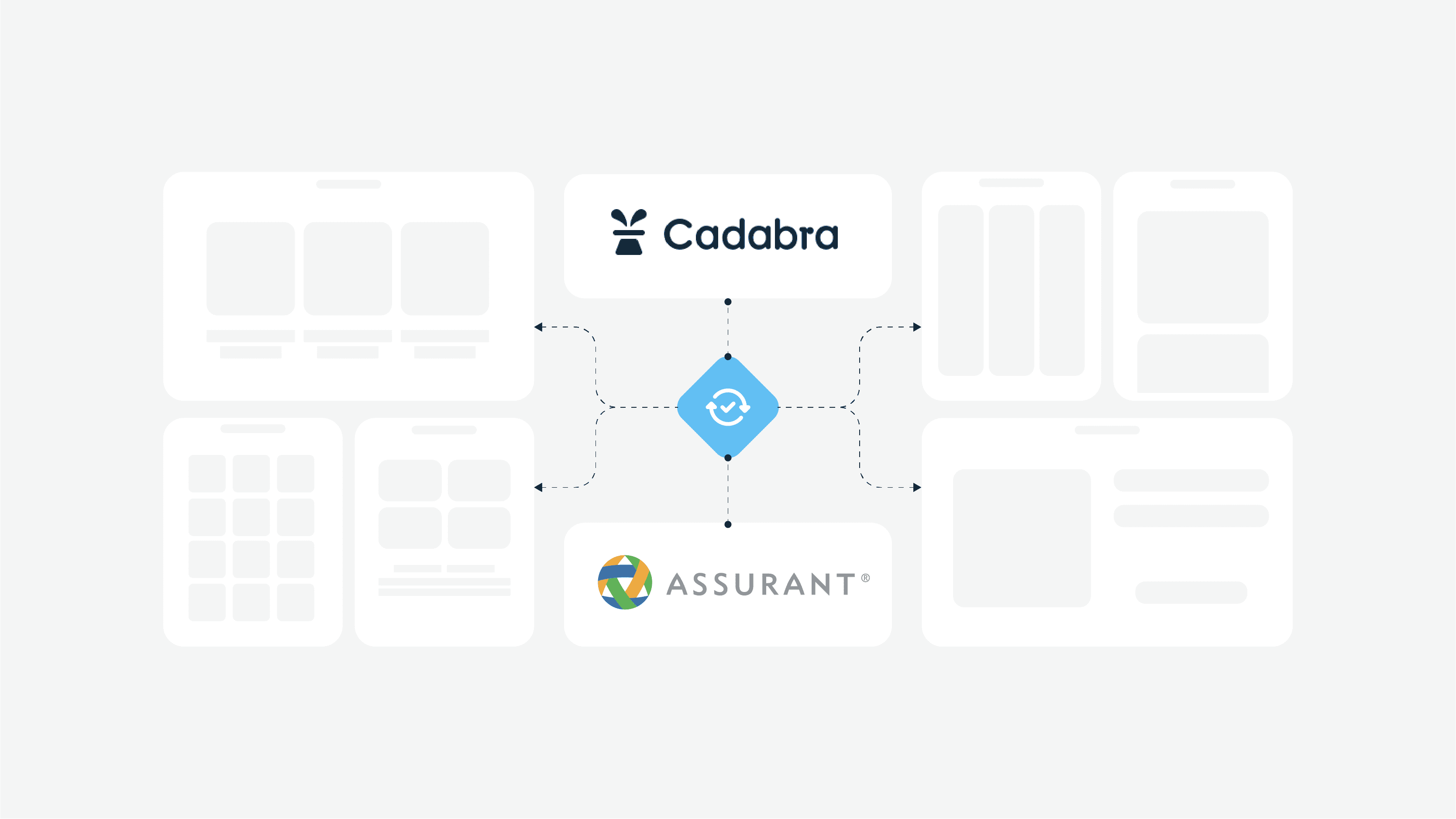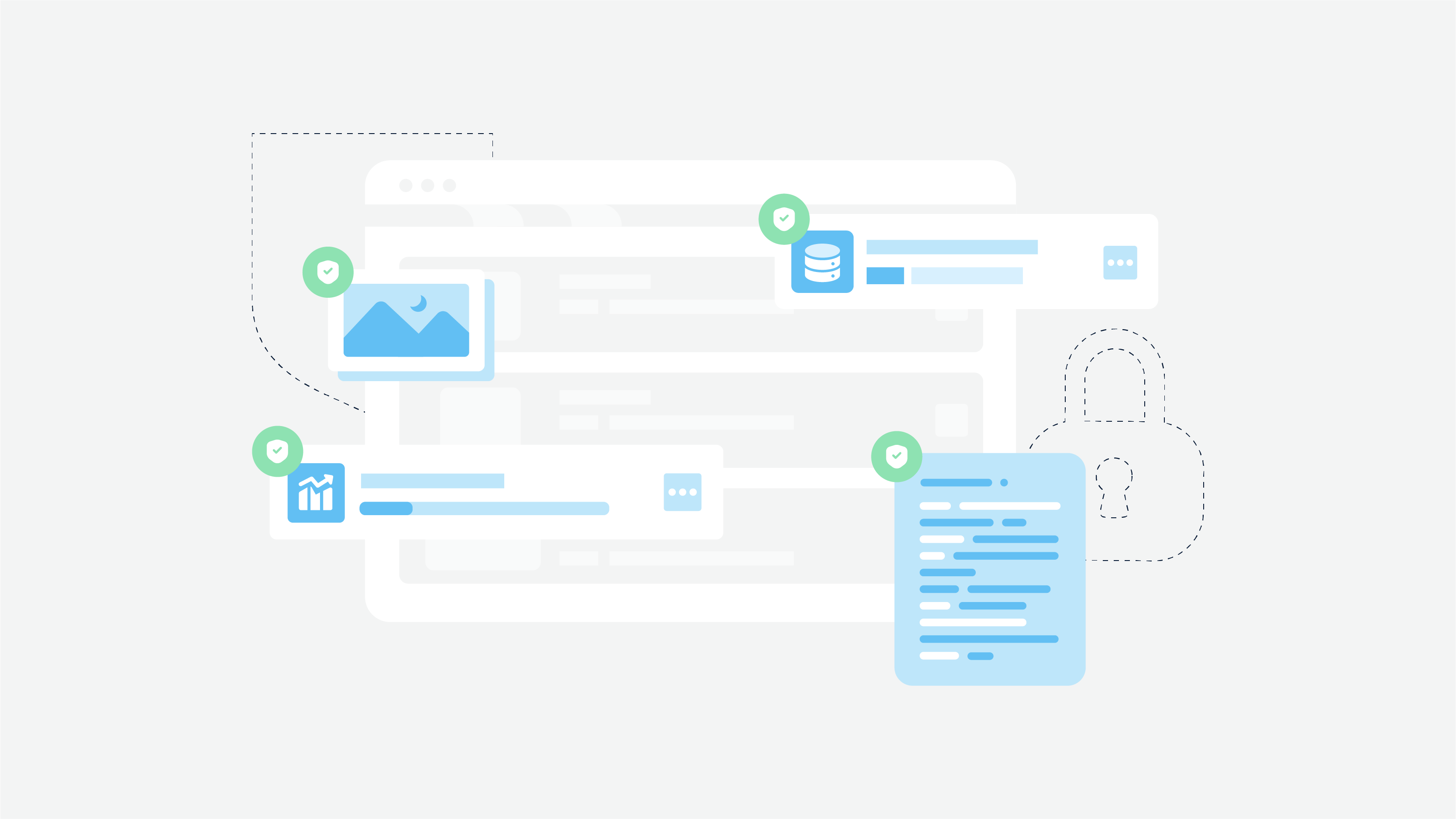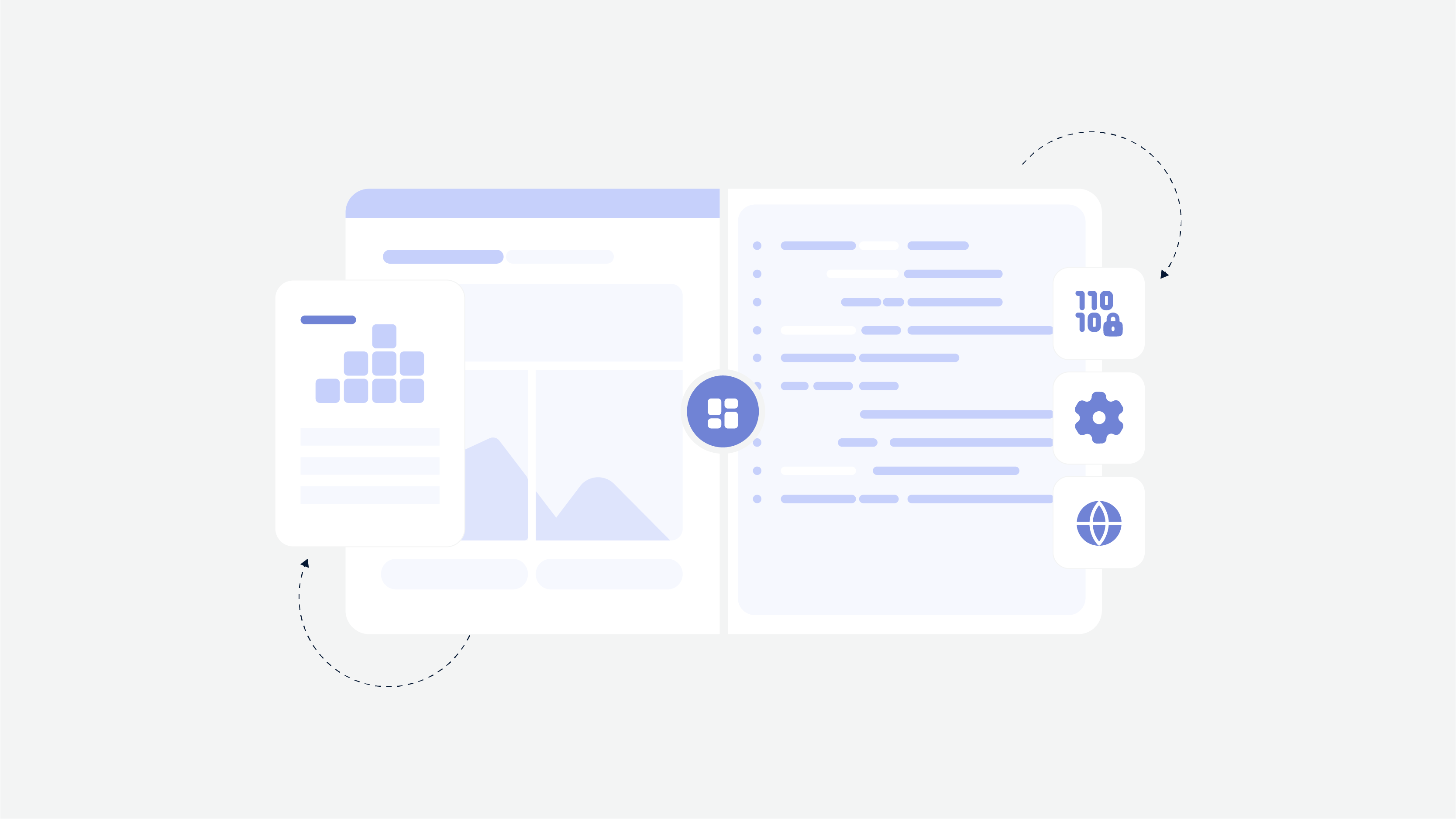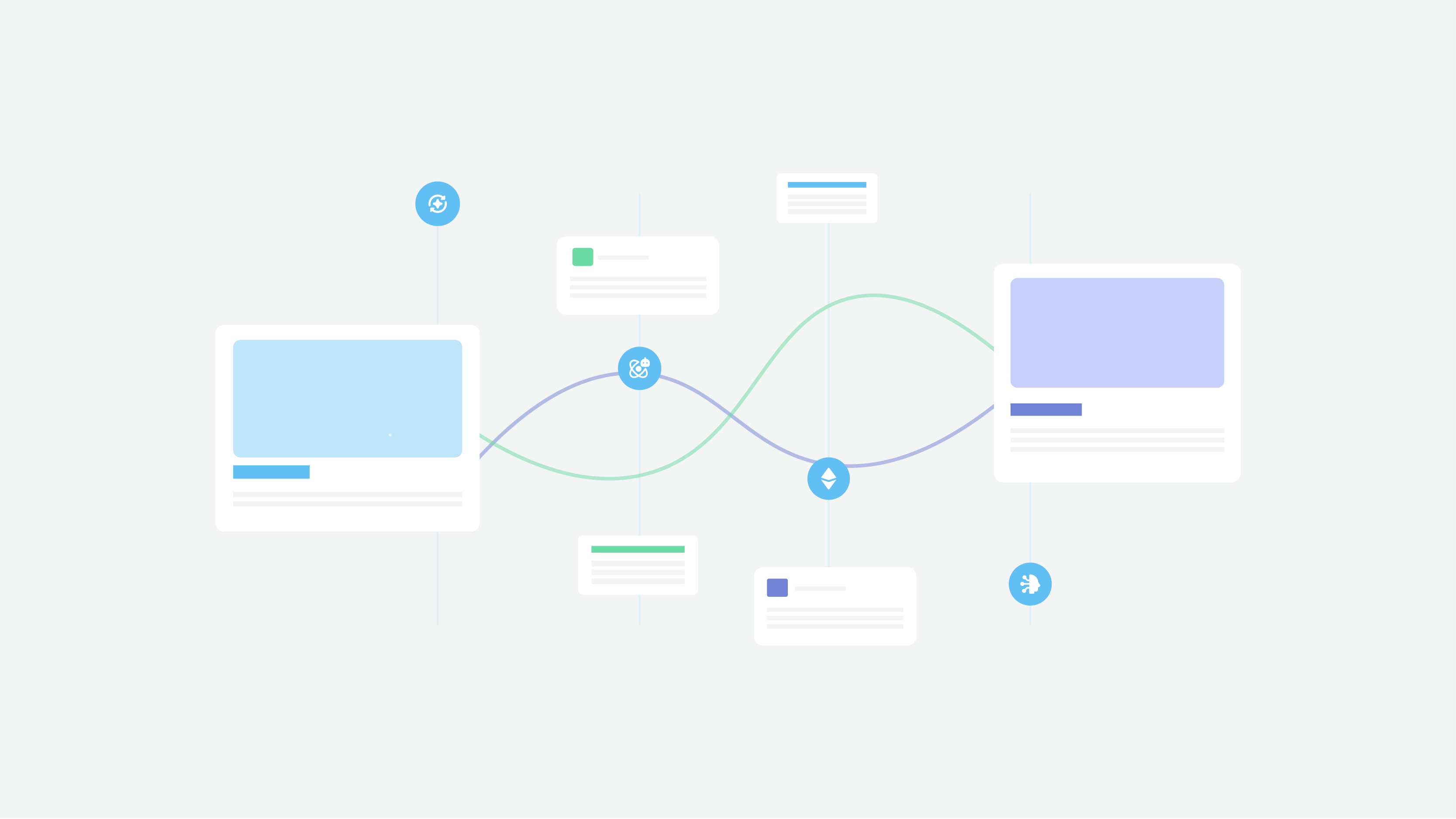User Experience (UX) design has evolved from a “nice-to-have” feature to a fundamental driver of business success. In today’s competitive landscape, great UX is essential for enhancing customer satisfaction, boosting operational efficiency, elevating retention rates, and driving revenue growth.
Neglecting UX design can damage your brand by leading to dissatisfied customers who share their negative experiences, altering public perception. For many decision-makers, particularly CTOs, product owners, and business stakeholders, justifying the investment in UX design can be challenging without clear, measurable data to back it up.
Understanding the ROI of UX design is crucial. By calculating and demonstrating the return on investment from UX initiatives, businesses can validate their design investments with concrete, tangible results.
What is UX Design and its Importance in Business
User Experience (UX) design is a critical component of software development, focusing on creating intuitive, easy-to-use products that deliver a positive user experience. In a business context, UX design is not just about aesthetics; it’s about understanding and meeting user needs to drive customer satisfaction and loyalty.
A well-designed UX can lead to increased customer satisfaction, which in turn fosters customer loyalty and retention. This positive user experience is a key driver of business growth and revenue. Companies that prioritize UX design often see a significant impact on their bottom line, as satisfied customers are more likely to return, recommend the product to others, and engage more with the brand.
The ROI of UX Design
What is UX ROI and Why Does It Matter?
UX ROI is the quantifiable return a business gains from investing in enhancements to the user experience. The ROI calculation is essential for understanding both the financial benefits and the qualitative aspects of UX design. It links design efforts to business outcomes such as increased sales, customer satisfaction, and operational savings.
Investing in UX improvements is crucial because they can lead to:
Reduced user frustration and abandonment rates, which often translate to lost sales and decreased customer loyalty.
Streamlined processes that save time and resources, enhancing overall operational efficiency.
Increased customer loyalty and lifetime value, as happy customers are more likely to remain loyal and continue engaging with the brand.
Higher conversion rates and revenue, as intuitive and user-friendly interfaces encourage users to take desired actions. Companies like Amazon, Airbnb, and Spotify attribute a significant portion of their success to robust UX strategies, highlighting the substantial financial impact of great design.
How UX Improvements Impact Revenue, Efficiency, and Customer Satisfaction
UX improvements have a direct and measurable impact on several key areas of business performance:
Revenue: By enhancing the user experience, businesses can achieve higher conversion rates and increased purchase frequency, leading to substantial revenue growth.
Efficiency: Streamlined interfaces and processes reduce user errors and operational inefficiencies, resulting in cost savings and increased productivity.
Customer Satisfaction: Providing intuitive and enjoyable experiences boosts brand loyalty and user happiness, fostering long-term customer relationships.
An improved user experience is directly linked to higher task success rates, justifying the investment in UX design.
UX Research: Understanding User Needs and Behaviors
UX research is a crucial aspect of UX design, involving the study of user needs, behaviors, and motivations. This research is vital for identifying pain points, opportunities, and areas for improvement in a product or service. UX research methods include user interviews, surveys, usability testing, and A/B testing. By conducting thorough UX research, designers can gain valuable insights into user behavior and preferences.
This data-driven approach ensures the final product meets user needs and expectations, resulting in a more intuitive and satisfying user experience. Understanding user behavior through UX research not only aids in creating better products but also aligns design strategies with business goals, enhancing brand reputation and business outcomes.
Gathering User Feedback for UX Design
Gathering user feedback is an essential step in the UX design process. It helps designers validate their design decisions, identify areas for improvement, and create products that meet user needs. User feedback can be collected through various methods, including usability testing, surveys, and user interviews.
By incorporating user feedback into the design process, designers can ensure the final product is intuitive, easy to use, and provides a positive user experience. This iterative process of collecting and acting on user feedback leads to continuous UX improvements, increased user satisfaction, and business success.
Moreover, user feedback provides actionable insights that can inform future design projects, ensuring the product evolves with user expectations and market trends.
Usability Testing: Evaluating Product Usability and User Experience
Usability testing is a method of evaluating product usability and user experience by observing users as they interact with a product or service. This process helps identify pain points and gather feedback on the product’s usability. Usability testing can be conducted in-person or remotely and provides valuable insights into user behavior and product usability.
By conducting usability testing, designers can pinpoint specific areas where users encounter difficulties and make design improvements. This results in a more intuitive and user-friendly product, enhancing the overall user experience. Usability testing is a crucial step in the UX design process, ensuring the product meets user needs and expectations, leading to increased customer satisfaction and loyalty.
Key Metrics for UX ROI
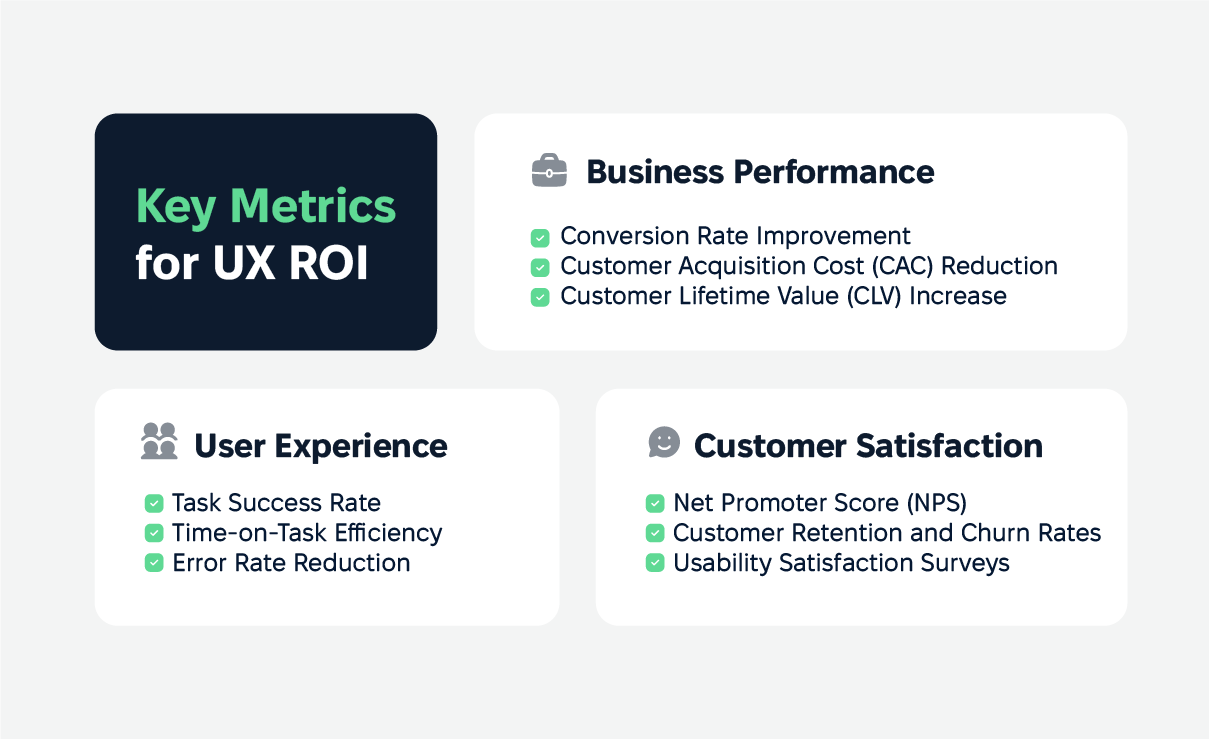
Business Performance Metrics
To measure the impact of UX on business performance, consider the following metrics:
Conversion Rate Improvement: A 1% increase in conversion rates can lead to significant revenue gains, making UX improvements a worthwhile investment.
Customer Acquisition Cost (CAC) Reduction: By providing smooth onboarding and seamless experiences, businesses can reduce marketing spend and lower the cost of acquiring new customers.
Customer Lifetime Value (CLV) Increase: Happier users stay longer, recommend the brand to others, and are less sensitive to price changes, increasing their overall lifetime value.
Investing in UX design can also help maintain or increase market share by providing a competitive edge. Neglecting UX can result in losing market share to competitors who prioritize it, affecting a business’s position as a market leader.
User Experience Metrics
To measure the effectiveness of UX improvements, focus on these user experience metrics:
Using tools like Google Analytics can significantly improve these user experience metrics by providing valuable data on user behavior and engagement.
Task Success Rate: This core usability metric measures the percentage of users who complete tasks successfully, indicating the effectiveness of the interface design.
Time-on-Task Efficiency: Shorter task completion times indicate better usability and happier users, who are more likely to return.
Error Rate Reduction: A decrease in user mistakes leads to improved satisfaction and lower support costs for users and the business.
Customer Satisfaction Metrics
Customer satisfaction is a critical component of UX ROI, and these metrics can help measure its impact:
Improving user satisfaction is key to revenue growth and customer loyalty.
Net Promoter Score (NPS): This measures customer loyalty and willingness to recommend the brand to others, reflecting overall satisfaction.
Customer Retention and Churn Rates: Higher retention rates are often a direct result of better UX, as satisfied customers are less likely to leave.
Usability Satisfaction Surveys: Collecting feedback from users post-redesign provides valuable insights into the effectiveness of UX improvements.
The ROI of UX Investments
Case Studies of UX ROI
Here are some real-life examples of businesses that have benefited from UX investments:
A SaaS company improved its onboarding UX and saw a 20% reduction in support costs, demonstrating the cost-saving potential of good UX design.
A global insurance provider redesigned its policy management portal and saw a 35% increase in policy renewals, highlighting the revenue growth potential of UX improvements.
Analyzing past projects is key to demonstrating the value of UX activities. By examining outcomes, businesses can identify patterns and trends that help predict the ROI of UX design and address client skepticism about the effectiveness and resource allocation for UX research and design.
Examples of Businesses That Increased Profitability Through UX
Airbnb enhanced its UX and experienced a direct 30% increase in bookings, showcasing the financial benefits of prioritizing UX.
Intuit redesigned TurboTax’s onboarding process and saw a significant revenue boost, illustrating the impact of user-friendly design on business success.
How to Calculate UX ROI
Step 1 – Identify UX Problems and Opportunities
The first step in calculating UX ROI is to identify areas for improvement:
User Research: Conduct surveys, interviews, and usability testing to identify friction points and areas where users encounter difficulties. For example, a team discovered customer resistance to a registration requirement and adjusted the design, significantly boosting sales.
Stakeholder Input: Align business goals with user needs to ensure UX improvements support overall objectives.
Step 2 – Quantify the Potential Gains
Once UX problems and opportunities are identified, quantify the potential gains:
Revenue Growth Projections: Forecast the impact of improved conversion rates on overall revenue to gain a clear picture of the financial gain. For example, a company decided to conduct usability testing after realizing their checkout process was negatively impacting revenue. This was key to identifying customer resistance to registration and implementing a redesign that significantly boosted sales.
Cost Saving Projections: Estimate reductions in customer support volume or onboarding time to demonstrate the cost-saving potential of UX improvements.
Step 3 – Measure UX Over Time
To ensure UX improvements deliver the expected results, measure them over time:
A/B Testing: Use A/B testing to demonstrate data-driven performance changes, providing concrete evidence of the effectiveness of UX improvements.
Data Analysis and Continuous Optimization: Use analytics tools to monitor user behavior and iterate on designs, ensuring UX improvements are continually optimized for maximum impact.
Knowing industry benchmarks and leveraging knowledge from other sectors is key to accurate ROI calculations, ensuring user research investments align with business objectives.
Simple ROI Formula:

ROI = (Financial Gain from UX Improvement – UX Investment Cost) / UX Investment Cost
For example, if a business invests $50,000 in UX and sees a $300,000 increase in revenue, the ROI would be calculated as follows: ROI = (300,000 – 50,000) / 50,000 = 500%.
UX ROI Challenges
Common Misconceptions About UX and ROI
Several common misconceptions about UX and its impact on ROI need to be addressed:
Myth 1: “UX is only about design.” In reality, UX encompasses much more than visual design; it involves the overall usability and functionality of a product or service.
Myth 2: “UX ROI can’t be measured.” While measuring UX ROI can be complex, it can be quantified through careful analysis and the right metrics.
Myth 3: “Only big companies benefit from UX.” Businesses of all sizes can benefit from UX improvements as they lead to better customer experiences and increased profitability.
A UX designer plays a key role in advocating for the business value of UX design and its impact on software development projects.
They educate clients on the ROI of UX activities, emphasizing that despite the challenges or misconceptions about time and resource allocation, the benefits will lead to better project outcomes.
How to Get Buy-In for UX Investments
Getting buy-in for UX investments requires a strategic approach:
Use Hard Numbers: Link UX to key performance indicators (KPIs) like revenue, conversion rates, and churn rates to demonstrate the impact on business success.
Tell User Stories: Humanize the data by sharing real user experiences and testimonials to illustrate the tangible benefits of UX improvements.
Benchmark Competitors: Highlight how other companies have improved UX to gain a competitive edge and emphasize the need to stay ahead in the market.
Ensuring all stakeholders within an organization are aligned on business objectives and UX initiatives is crucial. Clear communication and alignment on strategic goals and metrics like ROI will enable different departments to collaborate effectively and support long-term UX efforts.
Future of UX ROI Measurement
AI and Automation in UX Analytics
AI and automation are set to revolutionize UX analytics:
Predictive UX with AI will soon enable businesses to forecast conversion improvements before launching new designs, providing valuable insights into potential outcomes.
Real-time UX monitoring tools will automate ROI tracking, allowing businesses to measure the impact of their UX investments.
Predictive UX Metrics for Proactive Decision Making
With AI-driven analytics, businesses will be able to prioritize design changes based on expected impact:
Understanding and calculating ROI in a UX design project will set expectations and clarify and justify investments in user-centric strategies.
Early detection of usability issues through AI-driven analysis will allow businesses to address problems before they impact user experiences.
How Cadabra Helps Businesses Optimize UX for Maximum ROI
Cadabra’s UX Bridge and Redesign Services
Cadabra offers services to help businesses optimize their UX for maximum ROI:
UX Bridge: This service provides rapid UX audits and strategic improvement roadmaps tailored to each business, ensuring UX investments deliver the desired results.
Redesign Service: Cadabra’s full redesign services enhance conversions, retention, and efficiency, transforming user experiences and driving business success.
The design team needs to communicate ROI to stakeholders and track operational efficiency by KPIs.
How Cadabra’s Team Delivers Measurable UX Improvements
Cadabra’s team delivers measurable UX improvements by:
Data-driven design backed by real user research, ensuring UX changes are based on user needs and preferences.
Continuous monitoring and optimization post-launch, allowing businesses to refine their UX strategy and maximize impact.
Specialization in complex industries like healthcare and insurance, with tailored solutions for those sectors.
Conclusion
Why UX ROI Matters
Investing in UX has a direct and significant impact on business outcomes, resulting in increased revenue, lower costs, and higher customer loyalty. Understanding the ux roi provides businesses with the data needed to advocate for continued UX investment and drive long-term success.
Final Thoughts on Making UX a Core Business Investment
In today’s digital economy, businesses that prioritize UX not only survive but also thrive. By making UX a core business investment, companies can gain a competitive edge, foster customer loyalty, and achieve sustainable growth.
Want to Improve Your UX ROI? Let’s Talk!
Ready to transform your product experience and drive measurable results?
Book a free consultation with Cadabra Studio today. Let’s make your UX investment work harder for you!
FAQs
What is the ROI of UX design?
The ROI of UX design measures the financial return a business gains from its investment in user experience improvements. By enhancing user satisfaction and streamlining processes, businesses can achieve increased conversion rates, reduced development costs, and higher customer loyalty, all of which contribute to business success.
How do you calculate ROI for UX activities?
To calculate ROI for UX activities, use the formula: ROI = [(Financial Gains from UX Improvements – UX Investment Cost) / UX Investment Cost] × 100. This calculation reveals the business value of UX efforts, such as increased sales and cost savings.
Why is user feedback important in UX design?
User feedback is crucial in UX design as it provides actionable insights into user behavior and needs. By leveraging this data, UX designers can make informed design decisions that enhance user satisfaction and deliver a higher ROI.
How does UX research impact business goals?
UX research aligns design strategy with business goals by uncovering user needs and preferences. This research informs the development process, ensuring UX redesigns meet target audience expectations and ultimately fulfill business objectives.
What role does usability testing play in UX design ROI?
Usability testing identifies usability problems and validates design solutions, ensuring the product meets user needs and expectations. This process is integral to achieving increased customer satisfaction and loyalty, contributing to the overall ROI of UX design.

